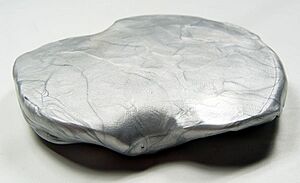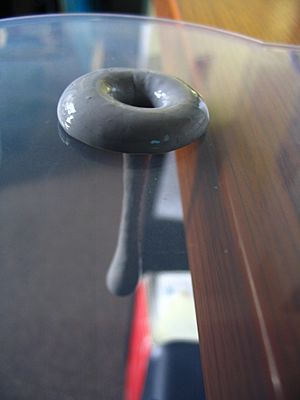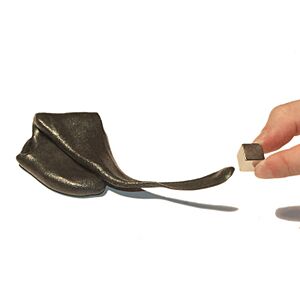Silly Putty facts for kids
Silly Putty is a fun toy made from silicone materials. It has some really cool and unusual properties! It can act like a liquid, flowing slowly over time. But it can also bounce like a ball, stretch out long, or even break if you pull it fast enough.
This happens because Silly Putty is a special kind of material called a non-Newtonian fluid. It's made of viscoelastic silicones. This means it acts like a thick liquid if you leave it alone for a while, but like a stretchy solid if you play with it quickly. Silly Putty was first made during World War II when people were trying to find a new type of rubber.
The name Silly Putty is a trademark owned by Crayola LLC. Other companies make similar products, but they use different names.
What is Silly Putty?
Silly Putty is famous for its unique features. It bounces high when you drop it. But if you hit it hard or pull it sharply, it will break. It can even float in water! If you leave it sitting for a long time, it will slowly spread out like a puddle. Most putties sold in stores have special ingredients that help them keep their shape better.
The original Silly Putty was a coral color. It's mostly made of a silicone material called dimethylsiloxane. It also contains silica (which is like sand), a castor oil product, and a few other ingredients.
Silly Putty's amazing ability to flow is due to an ingredient called polydimethylsiloxane (PDMS). This is a viscoelastic substance. Think of viscoelasticity as a material that can be both gooey and stretchy. It acts like a thick liquid over a long time. But it acts like an elastic solid over a short time. Because it gets thicker the more force you apply, Silly Putty is known as a dilatant fluid.
Silly Putty is also pretty good at sticking to things. In the past, when newspapers used oil-based ink, you could press Silly Putty onto a newspaper. It would pick up the ink and transfer the image! This was a fun way to stretch and distort pictures. Today's newspapers use different inks, so this trick doesn't work as well.
It can be tricky to get Silly Putty off things like dirt or clothes. Hand sanitizers that contain alcohol can often help. Alcohol makes Silly Putty dissolve. But once the alcohol dries, the putty won't have its special properties anymore.
If you put Silly Putty in warm or hot water, it gets much softer. It will "melt" faster and become harder to remove from surfaces. After a while, it will go back to its normal thickness.
Silly Putty is usually sold as a 13 gram (0.46 ounce) piece. It comes inside a plastic egg-shaped container. Crayola LLC owns the Silly Putty brand. As of a few years ago, about 20,000 eggs of Silly Putty were sold every day! Since 1950, over 300 million eggs have been sold. That's about 4,500 tons of putty! You can find it in many colors, including ones that glow in the dark or look metallic. Other brands offer similar materials. Some even have special features like magnetism or iridescence (shimmering colors).
How Silly Putty Was Invented
During World War II, there was a big shortage of natural rubber. Rubber was super important for making things like tires, rafts, and gas masks. The US government encouraged people to save rubber. They also funded research to find new materials that could replace rubber.
The invention of Silly Putty has a few different stories. Some say Earl L. Warrick of Dow Corning invented it. Others give credit to James Wright, an inventor working for General Electric. Both researchers independently discovered that mixing boric acid with silicone oil created a bouncy, gooey material. This new putty was not poisonous, could bounce, stretched more than regular rubber, and wouldn't get moldy. It also had a very high melting point. However, it wasn't quite right to replace rubber completely.
In 1949, a toy store owner named Ruth Fallgatter found the putty. She worked with a marketing expert named Peter C. L. Hodgson. They decided to sell the putty in clear cases. It sold well, but Ruth didn't continue with it. Peter Hodgson, however, saw its huge potential.
Even though he was in debt, Hodgson borrowed money to buy a batch of the putty. He put 1 ounce (28 grams) portions into plastic eggs and called it Silly Putty. He sold them for $1 each. At first, sales were slow. But after an article about it appeared in The New Yorker magazine, Hodgson sold over 250,000 eggs in just three days!
In 1951, the Korean War almost stopped his business. Silicone, the main ingredient, was rationed. But a year later, the rules changed, and Silly Putty production started again. It was first aimed at adults. But by 1955, most customers were kids aged six to twelve. In 1957, Hodgson made the first TV commercial for Silly Putty. It aired during the Howdy Doody Show.
In 1961, Silly Putty became popular around the world, even in the Soviet Union and Europe. In 1968, Apollo 8 astronauts even took it into lunar orbit with them!
Peter Hodgson passed away in 1976. A year later, Binney & Smith, the company that makes Crayola products, bought the rights to Silly Putty. It was inducted into the National Toy Hall of Fame on May 28, 2001.
Other Ways to Use Silly Putty
Besides being a fun toy, Silly Putty has other interesting uses. At home, you can use it to pick up dirt, lint, pet hair, or even ink from surfaces. Its special properties have also made it useful in medicine and science.
Occupational therapists use it to help people recover from hand injuries. Other brands, like Power Putty and TheraPutty, change the material's properties to offer different levels of resistance for therapy. It's also used to help reduce stress. You can find it in different thicknesses depending on what you prefer.
Because it's sticky, Apollo astronauts used it to hold their tools in place in space where there's no gravity. People who build scale models use it to cover parts they don't want to paint when spray-painting. The Steward Observatory even uses a special Silly Putty-backed tool to polish huge telescope mirrors!
Scientists at Trinity College Dublin found something amazing. They mixed tiny pieces of graphene with Silly Putty. This new material acts like a super sensitive pressure sensor. They claim it can even measure the tiny footsteps of a spider crawling on it!
See also
 In Spanish: Silly Putty para niños
In Spanish: Silly Putty para niños
- Blu Tack
- Flubber (material)
- Slime (toy)





